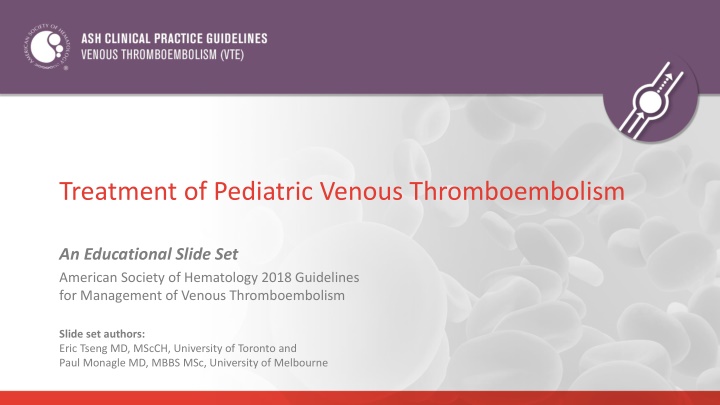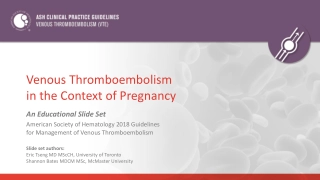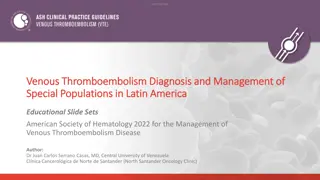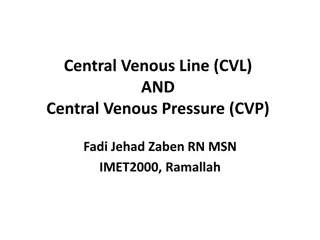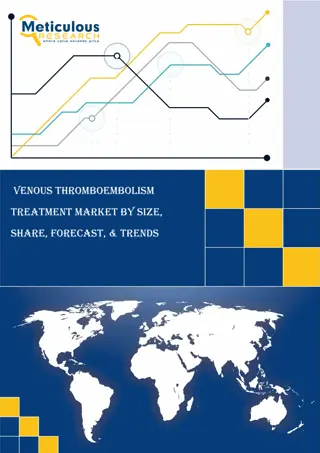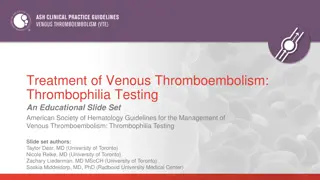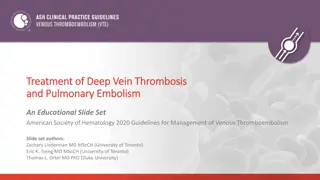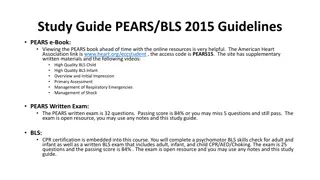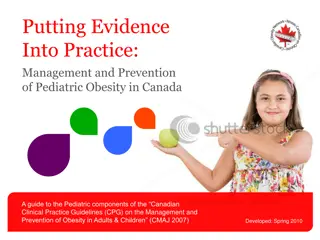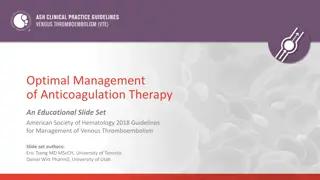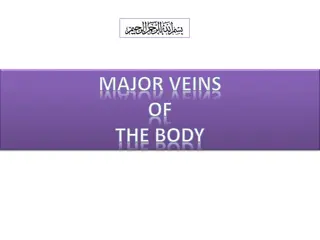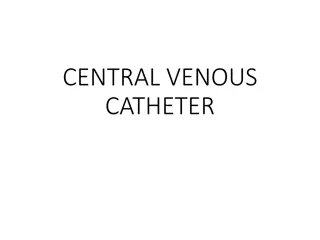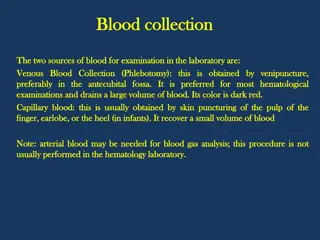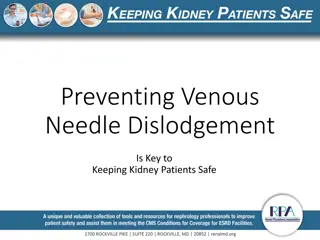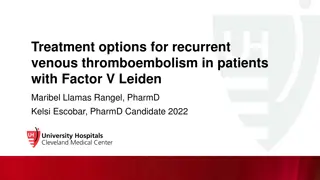Guidelines for Management of Pediatric Venous Thromboembolism
This educational slide set presents the American Society of Hematology's 2018 guidelines for the treatment of pediatric venous thromboembolism. The guidelines cover various aspects such as prevention, treatment, and optimal management of anticoagulation therapy in pediatric patients. Panels were formed with a balance of expertise and close attention to conflicts of interest. Clinical questions were generated in PICO format, and evidence was synthesized to make recommendations. These guidelines aim to assist patients and clinicians in making informed decisions on the management of pediatric VTE.
Download Presentation

Please find below an Image/Link to download the presentation.
The content on the website is provided AS IS for your information and personal use only. It may not be sold, licensed, or shared on other websites without obtaining consent from the author.If you encounter any issues during the download, it is possible that the publisher has removed the file from their server.
You are allowed to download the files provided on this website for personal or commercial use, subject to the condition that they are used lawfully. All files are the property of their respective owners.
The content on the website is provided AS IS for your information and personal use only. It may not be sold, licensed, or shared on other websites without obtaining consent from the author.
E N D
Presentation Transcript
Treatment of Pediatric Venous Thromboembolism An Educational Slide Set American Society of Hematology 2018 Guidelines for Management of Venous Thromboembolism Slide set authors: Eric Tseng MD, MScCH, University of Toronto and Paul Monagle MD, MBBS MSc, University of Melbourne
American Society of Hematology 2018 guidelines for management of venous thromboembolism: treatment of pediatric venous thromboembolism Paul Monagle, Carlos A. Cuello, Caitlin Augustine, Mariana Bonduel, Leonardo R. Brand o, Tammy Capman, Anthony K. C. Chan, Sheila Hanson, Christoph Male, Joerg Meerpohl, Fiona Newall, Sarah H. O Brien, Leslie Raffini, Heleen van Ommen, John Wiernikowski, Suzan Williams, Meha Bhatt, John J. Riva, Yetiani Roldan, Nicole Schwab, Reem A. Mustafa, and Sara K. Vesely
ASH Clinical Practice Guidelines on VTE 1. Prevention of VTE in Surgical Hospitalized Patients 2. Prevention of VTE in Medical Hospitalized Patients 3. Treatment of Acute VTE (DVT and PE) 4. Optimal Management of Anticoagulation Therapy 5. Prevention and Treatment of VTE in Patients with Cancer 6. Heparin-Induced Thrombocytopenia (HIT) 7. Thrombophilia 8. Pediatric VTE 9. VTE in the Context of Pregnancy 10. Diagnosis of VTE
How were these ASH guidelines developed? PANEL FORMATION Each guideline panel was formed following these key criteria: Balance of expertise (including disciplines beyond hematology, and patients) Close attention to minimization and management of conflicts of interest CLINICAL QUESTIONS 10 to 20 clinically- relevant questions generated in PICO format (population, intervention, comparison, outcome) EVIDENCE SYNTHESIS Evidence summary generated for each PICO question via systematic review of health effects plus: Resource use Feasibility Acceptability Equity Patient values and preferences MAKING RECOMMENDATIONS Recommendations made by guideline panel members based on evidence for all factors. Example: PICO question Should anticoagulation versus no therapy be used in neonates with renal vein thrombosis?
How patients and clinicians should use these recommendations STRONG Recommendation ( The panel recommends ) CONDITIONAL Recommendation ( The panel suggests ) Most individuals would want the intervention. A majority would want the intervention, but many would not. For patients Different choices will be appropriate for different patients, depending on their values and preferences. Use shared decision making. Most individuals should receive the intervention. For clinicians
Objectives By the end of this session, you should be able to 1. Describe recommendations for the management of renal vein thrombosis in neonates 2. Describe recommendations for the management of VTE associated with central venous access devices (CVAD) in children 3. Describe recommendations for the management of symptomatic and asymptomatic VTE in children
Pediatric venous thrombosis is a disease primarily of sick children VTE in the general pediatric population is rare (0.07 to 0.14 per 10,000 children) The rate of VTE in children is increased by 100 to 1,000 times in hospitalized children Presence of central venous catheter is main precipitant for VTE in neonates (90% of all VTE) and other children (60%+) There are no anticoagulant drugs approved for use in children, with little pediatric-specific VTE research
What this guidelines chapter is about Whether to treat and what type of treatment in different scenarios Mostly does not address optimal use of anticoagulants (dose, intensity, duration) or monitoring Anticoagulation refers to unfractionated heparin (UFH), low molecular weight heparin (LMWH), fondaparinux, vitamin K antagonists (VKA) Direct oral anticoagulants outside scope of guidelines given paucity of published pharmacokinetic, safety, or efficacy studies in children
Case 1: Gross Hematuria in a Neonate 3,800 gram male infant Born at 39 weeks gestational age to 35 year old mother with gestational diabetes managed by diet and insulin during pregnancy On Day 1: Gross hematuria and palpable mass in left mid-abdomen. Leukocytes 25 x 109/L, platelets 90 x 109/L. Serum creatinine is normal. Blood pressure is 85/40 (normal)
Case 1: Gross Hematuria in a Neonate Doppler ultrasound: swollen echogenic left kidney with prominent medullary pyramids, absent renal venous flow with occlusive clot visualised in the renal vein extending to the junction with the inferior vena cava Consistent with unilateral (left) renal vein thrombosis without extension to inferior vena cava.
This neonate has developed unilateral renal vein thrombosis (RVT), without extension to the IVC. His platelet count is 90 x 109/L and he is hemodynamically stable. What would you suggest as the next step in his management? A. No anticoagulation, repeat ultrasound to ensure no extension B. Anticoagulation therapy C. Thrombolytic therapy D. Surgical thrombectomy
Recommendation The panel suggests using anticoagulation rather than no anticoagulation in neonates with RVT(conditional recommendation, very low certainty) NOTES: 9 observational studies in children (total 175 patients) case reports and case series Direct comparison of outcomes difficult as high likelihood of selection bias for which neonates were offered anticoagulation or not Anticoagulation considered to have potential benefit when long term benefits considered: Avoiding hypertension Potential renal damage Anticoagulation likely more important with: Bilateral RVT (life-threatening due to acute renal dysfunction) Progression to IVC (higher embolic risk) Bleeding risk with treatment is likely impacted by Severity of disease Age, gestational age Degree of thrombocytopenia, Degree of renal dysfunction Involvement of adrenal glands
Recommendation In cases with non-life threatening RVT (ex. unilateral): High value placed on avoiding bleeding Thrombolysis not recommended (strong recommendation, very low certainty) In cases with life-threatening RVT (ex. bilateral): Potential benefits of thrombolysis felt outweigh risks Thrombolysis suggested (conditional recommendation, very low certainty) In observational studies of patients receiving thrombolysis (n = 24), outcomes were mortality 0%, no resolution of RVT 8%, long-term renal impairment 75%, hypertension 22%; major bleeding 21%
Case 1: Conclusion Your patient with unilateral RVT is started on therapeutic anticoagulation with LMWH Within 48 hours his hematuria resolves and he remains clinically stable, with no progression of thrombosis He continues LMWH on discharge, and his ultrasound at 12 weeks demonstrates partial recanalization of the left renal vein Long term follow up of blood pressure and renal function will be required
Case 1: Summary Anticoagulation without thrombolysis is recommended as front-line therapy for all RVT, but especially in neonates with bilateral disease or extension to the IVC Decisions about anticoagulation should consider both immediate consequences and long-term potential benefits to renal function and avoidance of hypertension Therapy should consider risks for bleeding, including degree of thrombocytopenia, renal dysfunction, and patient age
Case 2: CVAD-Related Thrombosis in ALL 10 year old female with acute lymphoblastic leukemia (ALL) Chemotherapy: Receiving induction with asparaginase-containing chemotherapy via Hickman central venous access device (CVAD) Presents to oncology clinic with: 36 hours of right upper arm and forearm swelling and redness. The line is functioning normally for administration of chemotherapy and regular flushing.
Case 2: CVAD-Related Thrombosis in ALL Doppler ultrasound of right upper extremity: Non-compressibility at right internal jugular vein. On Doppler flow, the clot extends into the subclavian vein, although the brachiocephalic vein and superior vena cava appear patent.
Your patient who is receiving asparaginase-based chemotherapy has an acute central line-associated right internal jugular vein DVT. The line is functioning properly. She requires additional treatments for induction chemotherapy In addition to providing anticoagulant therapy, what would you suggest next in her management? A. Remove central line, provide antithrombin (AT) replacement B. Remove central line, do not provide AT replacement C. Do not remove central line, provide AT replacement D. Do not remove central line, do not provide AT replacement
Recommendation The panel suggests no removal rather than removal of a functioning CVAD, in pediatric patients with symptomatic CVAD-related thrombosis who continue to require venous access (conditional recommendation, very low certainty) Remarks: High value on avoiding insertion of another CVAD in children who may have limited access sites Placing another line may cause new endothelial injury and be thrombogenic
Recommendation The panel suggests against using AT replacement therapy in addition to standard anticoagulation, and rather use standard anticoagulation alone in pediatric patients with DVT/PE/cerebral vein thrombosis (CSVT) (conditional recommendation, very low certainty) AT replacement with anticoagulation versus anticoagulation alone for DVT, PE, or CSVT: Anticipated absolute effects (95% CI) Very low certainty about benefits and adverse effects. However: No evidence that AT reduces risk of progressive VTE Possible that it may increase bleeding Relative effect (95% CI) Outcomes Risk with no AT replacement Risk difference with AT replacement RR 1.63 (0.25 to 10.52) 27 more deaths per 1,000 (32 fewer to 401 more) Mortality 42 per 1,000 DVT (symptomatic and asymptomatic) RR 0.71 (0.36 to 1.39) 99 fewer DVT per 1,000 (219 fewer to 134 more) 342 per 1,000 Infant bleeding - severe RR 1.20 (0.87 to 1.64) 44 more bleeds per 1,000 (29 fewer to 140 more) 220 per 1,000 Quality of Evidence (GRADE): Low Moderate Strong
Caveat: Subgroups when AT replacement might be justified, if the patient is failing to clinically respond to initial anticoagulation Children with age-appropriate low level of AT Children with ALL on induction chemotherapy using asparaginase Nephrotic syndrome Neonates Liver transplant patients Disseminated intravascular coagulation and VTE Known inherited AT deficiency
Case 2: Continued You start your patient on standard anticoagulation with LMWH, and despite dose escalation, the anti Xa levels remain sub-therapeutic. After 7 days, there has been worsening in arm swelling and discomfort The oncology nurses now report they are having substantial difficulty using the line, and are unable to flush it or administer chemotherapy You repeat a doppler ultrasound of the right upper extremity. It now demonstrates extension of DVT, with thrombus in the internal jugular, subclavian, brachiocephalic vein and superior vena cava (previously only internal jugular vein)
Your patient who is receiving asparaginase-based chemotherapy for ALL has developed progression of thrombosis despite standard anticoagulation therapy with LMWH. The line is not functioning properly anymore. Should the central venous catheter be removed? A. B. C. D. Yes, it should be removed as soon as practicable Yes, but removal should be delayed until end of anticoagulation treatment No, because removal may cause pulmonary embolism No, because removal may precipitate endothelial injury and worsening DVT
Recommendation The panel recommends removal rather than no removal of a non-functioning or unneeded CVAD, in pediatric patients with symptomatic CVAD-related thrombosis (strong recommendation, very low certainty) Overriding principle: any central access device should be removed as soon as feasible within the confines of the overall treatment of the child
Anticoagulation should be started before device removal, to reduce embolic risk Recommendation The panel suggests delayed removal of a CVAD until after initiation of anticoagulation (days) rather than immediate removal in pediatric patients with symptomatic central venous line-related thrombosis who no longer require venous access or their CVAD is non-functioning(condition recommendation, very low certainty) Optimal Timing of Removal? Uncertain. A few (3 to 5) days of anticoagulation are felt to reduce potential risk of emboli leading to PE or paradoxical stroke, although quality of evidence uncertain as no outcome data Considerations affecting timing: Known or suspected right to left shunt Surgeon, operating room availability In this case the child has already received 7 days therapy, so can proceed to remove as soon as possible
Your patient who is receiving asparaginase-based chemotherapy has developed progressive thrombosis despite standard anticoagulation therapy with LMWH. The line is not functioning properly anymore. What would you suggest for management of her antithrombotic therapy at this point? A. B. C. D. Continue with current LMWH regimen Switch anticoagulant therapy to intravenous unfractionated heparin Add empiric AT replacement therapy to current LMWH regimen Measure AT activity level, and if low then add AT replacement therapy to current LMWH regimen
Recommendation The panel suggests using AT replacement therapy in addition to standard anticoagulation rather than standard anticoagulation alone in pediatric patients with DVT/PE/CSVT who: Have failed to respond clinically to standard anticoagulation treatment and In whom subsequent measurement of AT concentrations reveals low AT levels based on age appropriate reference ranges (conditional recommendation, very low certainty) Antithrombin replacement would be commenced if there was continuous thrombus growth and/or failure of clinical response despite adequate anticoagulation However, there is no evidence to suggest improved outcomes in these patients with AT replacement
Case 2: Conclusion You measure an antithrombin activity level and determine that it is low: AT activity 0.12 U/mL (normal > 0.80) You supplement standard LMWH anticoagulation with AT concentrate, and within 3 days there is symptomatic improvement The CVAD is removed, and a central venous catheter is placed at another venous access site for subsequent chemotherapy treatments
Case 2: Summary When thrombosis occurs in association with a CVAD, the CVAD should only be removed if it is no longer functional or if its use is no longer required AT replacement therapy is not routinely recommended for the treatment of pediatric DVT, PE, or CSVT Certain subgroups may benefit from the addition of AT replacement to anticoagulation if they fail to respond to standard anticoagulation and their AT level is low, including those receiving asparaginase
Case 3: Asymptomatic DVT 4 year old female Surgery: Underwent open repair of ventricular septal defect (VSD). Intra-operatively a right internal jugular vein central venous catheter was inserted. Post-operatively: Recovering well. Central venous catheter was removed immediately post operative.
Case 3: Asymptomatic DVT Currently: 3 days since surgery, she undergoes routine echocardiography to review VSD closure. Thought that there was something abnormal in superior vena cava. Ultrasound: Non-occlusive thrombus noted in right internal jugular vain extending down into superior vena cava, but not into right atrium. No DVT in remaining veins of the upper extremity.
You have diagnosed your patient with an asymptomatic non-occlusive DVT in the internal jugular vein and superior vena cava, which was likely provoked by a central venous catheter that has been removed. What management would you suggest for this patient s asymptomatic DVT? A. B. C. D. E. Therapeutic anticoagulation No anticoagulation, as this was an incidental finding No anticoagulation, repeat ultrasound within 1 week to ensure no extension Graduated compression stockings Intermittent pneumatic compression devices A, B, or C are all reasonable options.
Recommendation The panel suggests either using anticoagulation or no anticoagulation in pediatric patients with asymptomatic DVT or PE (conditional recommendation, very low certainty) Remarks: Adult data suggests that treatment of most asymptomatic VTE is not required Challenging to extrapolate to children given differences in anatomy, pathophysiology Routine radiological screening for asymptomatic VTE should not be done If detected, decision to treat or not treat should be individualized Natural history and effects of anticoagulant therapy for asymptomatic VTE in children is uncertain. Treatment decision should be individualized
Case 3: Continued You decide to withhold anticoagulant therapy, given that the burden of thrombus is small and the line has already been removed You monitor her with a repeat ultrasound of the neck in 6 days, and the thrombus that was previously visualized is significantly reduced in size She is discharged home from hospital without anticoagulant therapy
Case 3: Continued 6 months later, after investigation for complex arrhythmias, she undergoes a cardiac catheter procedure to ablate an accessory pathway and is accessed via her right femoral vein. The next day, she develops right leg pain and swelling. Compression ultrasound of the affected leg reveals an occlusive DVT involving the femoral and popliteal veins. Repeat imaging of her neck at this time shows total resolution of her initial asymptomatic thrombosis.
Your patient now has a symptomatic proximal DVT, provoked by cardiac catheter in her right femoral vein. What management would you recommend for her DVT? A. B. C. D. E. No anticoagulation, as the procedure is over and she no longer has right to left shunting since her surgery Anticoagulation therapy Catheter-directed thrombolysis followed by anticoagulation Surgical thrombectomy followed by anticoagulation Insertion of prophylactic IVC filter, to reduce risk of PE
Recommendations The panel recommends using anticoagulation rather than no anticoagulation in pediatric patients with symptomatic DVT or PE (strong recommendation, very low certainty) The panel suggests against using IVC filter, and rather use anticoagulation alone in pediatric patients with symptomatic DVT or PE (conditional recommendation, very low certainty) Remarks: Majority of evidence for treatment of VTE in children is extrapolated from adults Most VTE occurs in sick hospitalized children, in whom VTE is often life-threatening Reserve IVC filter use for: DVT with absolute contraindication to anticoagulation Failure of adequate anticoagulant therapy, if filter felt to reduce embolic risk
Recommendation The panel suggests against using thrombolysis followed by anticoagulation, and rather use anticoagulation alone in pediatric patients with DVT(conditional recommendation, very low certainty) Pooled data from 15 observational studies in children reporting clinical outcomes with thrombolysis for DVT: Based on this limited data and extrapolation from adults, unlikely that thrombolysis reduces risk of recurrent VTE, but likely increases risk of bleeding. Mortality: 3.6% Progressive VTE or failure of VTE resolution: 22.2% Major bleeding: 5.7% Post-thrombotic syndrome: 9.5% Therefore, thrombolysis should be restricted to limb- or life-threatening cases.
Provoked VTE should only be treated with 3 months or less in pediatric patients Recommendation The panel suggests using anticoagulation for 3 months or less rather than anticoagulation for longer than 3 months in pediatric patients with provoked DVT or PE(conditional recommendation, very low certainty) Pediatric data from one observational study (n = 90) demonstrated possible reduction in VTE recurrence, but used variable durations of therapy. Optimal duration of anticoagulation is unknown. Extrapolation from adult data suggests that treating beyond 3 months not needed. However, if provoking risk factor persists, consider longer duration.
You start your patient on therapeutic anticoagulation with LMWH. You need to make arrangements for her outpatient anticoagulant management. Which of the following anticoagulants would you suggest as maintenance anticoagulation therapy after the first few days of LMWH? A or B are reasonable options A. B. C. D. E. LMWH Vitamin K antagonist Rivaroxaban Subcutaneous unfractionated heparin Fondaparinux
Recommendations The panel suggests using either LMWH or vitamin K antagonists (VKA) in pediatric patients with symptomatic DVT or PE (conditional recommendation, very low certainty) One RCT (REVIVE) stopped early due to low recruitment (n = 76) Wide confidence intervals preclude conclusions regarding clinical impact on VTE outcomes or bleeding 18 observational studies using either VKA or LMWH (mostly case series) Challenging to draw firm conclusions In the absence of robust pediatric-specific data, decision regarding LMWH compared with VKA should consider: Patient values and preferences Health services resource, infrastructure, and support Underlying condition, comorbidities, other medications Massicotte Thrombos Res 2003
Case 3: Conclusion The patient and family decide to continue with LMWH after discharge The parents are taught injection technique, and you check to ensure their private drug coverage provides access to LMWH They provide anticoagulant therapy for a total of 3 months. Her symptoms of DVT completely resolve within 2 weeks and she has complete radiological resolution at 3 months.
Case 3: Summary The management of asymptomatic VTE should be an individualized decision based on patient-specific risks for recurrent VTE and bleeding Thrombolysis and IVC filters should not routinely be used in the management of DVT or PE in children The choice between LMWH and vitamin K antagonist for maintenance anticoagulation should be made in a process of shared decision-making with patients and their families
Other guideline recommendations that were not covered in this session For these topics, conditional recommendations were made based on weak or very weak quality of evidence Role of thrombolysis for submassive and massive PE Management of unprovoked DVT or PE CVAD-related superficial venous thrombosis Right atrial thrombosis Unusual locations: cerebral vein thrombosis, portal vein thrombosis Purpura fulminans due to homozygous Protein C Deficiency
Future Priorities for Research More data regarding baseline risk of RVT Identifying subgroups of RVT who would benefit from thrombolysis Effect of antithrombin replacement in different pediatric subgroups Optimal duration of therapy for different provoking risk factors Impact of age on optimal duration of therapy for provoked VTE Data regarding natural history of asymptomatic VTE Role of catheter directed thrombolysis for DVT in children
In Summary: Back to our Objectives 1. Describe recommendations for the management of renal vein thrombosis in neonates Anticoagulation for non-life threatening cases; consider thrombolysis for life-threatening cases 2. Describe recommendations for the management of VTE associated with central venous access devices (CVAD) in children Anticoagulation is first-line therapy for symptomatic CVAD-associated VTE Removal or non-removal of CVAD depends on its functional status and patient treatment requirements 3. Describe recommendations for the management of symptomatic and asymptomatic VTE in children Symptomatic VTE should be treated with LMWH or vitamin K antagonist Management of asymptomatic VTE should be individualized
Acknowledgements ASH Guideline Panel team members Knowledge Synthesis team members McMaster University GRADE Centre Author of ASH VTE Slide Sets: Eric Tseng MD MScCH, University of Toronto and Paul Monagle MD MBBS MSc, University of Melbourne, Royal Children s Hospital See more about the ASH VTE guidelines at http://www.hematology.org/VTEguidelines
